Road gravel, Puhipuhi, Northland.
- The Puhipuhi area has several mercury-rich deposits formed by ancient hot spring systems associated with eruption of volcanic rocks in the area.
- These deposits are rich in quartz and are therefore hard compared to surrounding soft clay-rich rocks.
- This material was quarried for road gravel on public and private roads in the area.
- The road gravel contains marcasite (FeS2) with trace amounts of mercury and arsenic, and some other As/Hg bearing minerals.
- The marcasite oxidises in rainwater, and roads typically have a pH of 3.
- Complaints occurred of discharges from roads of acid waters with sediments containing elevated As & Hg.
- Extensive sealing and concrete guttering has been necessary to prevent these discharges into waters used for agricultural purposes.
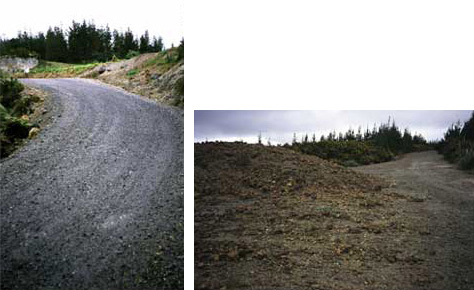
Puhipuhi road gravel that releases acid and metals.
Characteristic features of rocks and drainage at Puhipuhi
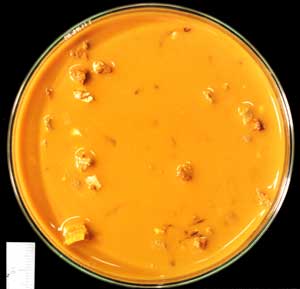 Sample of typical orange-stained water which flows from rocks in which marcasite and pyrite (iron sulphides) are decomposing in rain water.The orange pigment (iron oxide) forms when acid water mixes with clean water. Mercury and arsenic can stick to the orange pigment, removing these pollutants from the water. However, the mercury and arsenic may be picked up by other waters at a later time.
Sample of typical orange-stained water which flows from rocks in which marcasite and pyrite (iron sulphides) are decomposing in rain water.The orange pigment (iron oxide) forms when acid water mixes with clean water. Mercury and arsenic can stick to the orange pigment, removing these pollutants from the water. However, the mercury and arsenic may be picked up by other waters at a later time.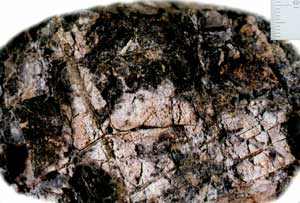 Greywacke (pale) and argillite (black) have been altered (bleached) by hot spring waters moving through fractures. The hot water left behind a deposit of marcasite in some fractures (indicated in rectangle). The marcasite is dark coloured, but fresh surfaces sometimes look brassy-yellow. Broken marcasite has a sulphurous odour.
Greywacke (pale) and argillite (black) have been altered (bleached) by hot spring waters moving through fractures. The hot water left behind a deposit of marcasite in some fractures (indicated in rectangle). The marcasite is dark coloured, but fresh surfaces sometimes look brassy-yellow. Broken marcasite has a sulphurous odour.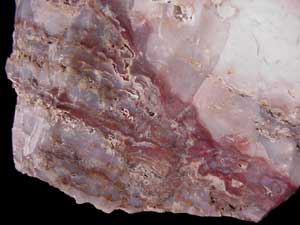 Pale quartz-rich rock deposited on top of the basalt by surface hot springs at Puhipuhi. The spring water also deposited cinnabar (red mercury sulphide) as thin layers in this rock. Cinnabar consists of about 80% mercury, but it is a stable mineral and does not break down in rain water. Hence cinnabar is not a potential pollutant.
Pale quartz-rich rock deposited on top of the basalt by surface hot springs at Puhipuhi. The spring water also deposited cinnabar (red mercury sulphide) as thin layers in this rock. Cinnabar consists of about 80% mercury, but it is a stable mineral and does not break down in rain water. Hence cinnabar is not a potential pollutant.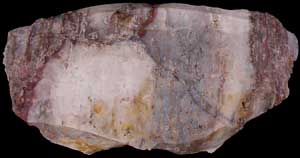 Same rock specimen as above.
Same rock specimen as above.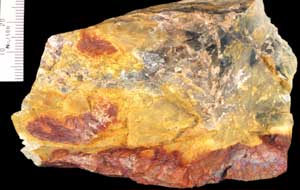 Same rock specimen as above, showing the outside surface. The yellow-brown stain on the rock surface is formed as the pyrite and marcasite decompose in rainwater to jarosite (yellow sulphate mineral) and limonite (brown rusty iron oxide).
Same rock specimen as above, showing the outside surface. The yellow-brown stain on the rock surface is formed as the pyrite and marcasite decompose in rainwater to jarosite (yellow sulphate mineral) and limonite (brown rusty iron oxide).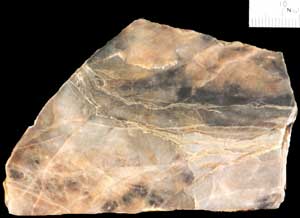 Quartz-rich rock deposited by hot spring waters as they passed through greywacke at Puhipuhi.
Quartz-rich rock deposited by hot spring waters as they passed through greywacke at Puhipuhi.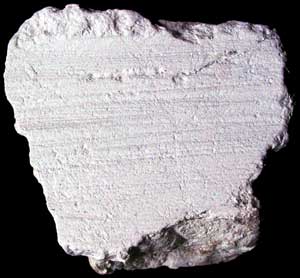 White clay formed from greywacke as hot spring waters moved through fractures. The clay is very soft and washes away in heavy rain. Dark specks are marcasite (iron sulphide).
White clay formed from greywacke as hot spring waters moved through fractures. The clay is very soft and washes away in heavy rain. Dark specks are marcasite (iron sulphide).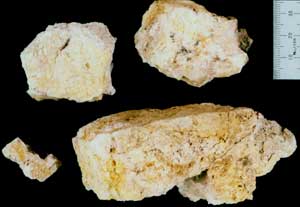 Similar clay material to that shown above. Yellow-brown stains are due to decomposition of marcasite in rain water, leaving jarosite (yellow sulphide mineral) and limonite (rusty brown iron oxide). This decomposition of marcasite releases sulphuric acid, arsenic and mercury.
Similar clay material to that shown above. Yellow-brown stains are due to decomposition of marcasite in rain water, leaving jarosite (yellow sulphide mineral) and limonite (rusty brown iron oxide). This decomposition of marcasite releases sulphuric acid, arsenic and mercury.Related
Introduction
Overview: Geological setting for Metals in the New Zealand environment
- Epithermal Gold
- Mesothermal Gold
- Acid Rock drainage
- Coal
- Metals in groundwater
- Alluvial Gold
- Northland Mercury
- Hot Springs (in heavy metals)